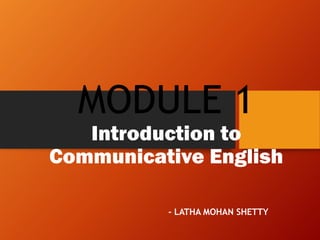
Communicative English-Module 1.pdf
- 1. MODULE 1 Introduction to Communicative English - LATHA MOHAN SHETTY
- 3. • The word ‘communication’ is derived from the Latin words ‘communico’ or ‘communicare’, which means ‘to share’. • Centre of communication – ‘YOU’ • We communicate in every situation. • “Language is to be learnt, Communication is to be developed.”
- 4. KEY TO SUCCESS • Four major skills of language learning are: LSRW L – Listening S – Speaking R – Reading W – Writing “COMMUNICATE…COMMUNICATE… COMMUNICATE”
- 5. DIFFERENCES GENERAL COMMUNICATION TECHNICAL COMMUNICATION Formal and informal communication Formal communication General content Technical content No set pattern of communication Follows a set pattern of communication Oral form Oral and written forms Not always for a specific audience Always for a specific audience Does not involve the use of technical vocabulary, graphics, etc. Involves the use of technical vocabulary, graphics, etc. Used by society in general Used by professionals belonging to business Personal Impersonal
- 8. 1) A well-defined communication environment 2) Always keep the receiver in mind 3) Be aware of diversity in culture, language, etc. 4) Use of appropriate non-verbal cues 5) Co-operation between sender and receiver 6) Selection of an appropriate channel 7) Proper encoding and decoding of the message 8) No communication when one is emotionally disturbed 9) Desired feedback should be received 10) Analyze the feedback
- 10. A. TYPES ➢ Extrapersonal ➢ Intrapersonal ➢ Interpersonal ➢ Organizational → Internal → External → Personal ➢ Mass / Media
- 14. A. TYPES ❑Organizational → Internal Among employees within a company
- 15. A. TYPES ❑Organizational → External With external parties outside the company
- 16. A. Types ❑Organizational → Personal/Grapevine Informal and unofficial (gossip/rumor) channel of business communication irrespective of the authority levels.
- 17. A. TYPES ❑Mass / Media Reaches a large audience Technologies include a variety of outlets -films, radio, recorded music, or television
- 18. B. FLOW ❑Vertical → Downward → Upward ❑Horizontal ❑Spiral ❑Diagonal/Crosswise
- 19. B. FLOW ❑Vertical → Downward → Upward
- 21. B. FLOW ❑Spiral
- 22. B. FLOW ❑Diagonal / Crosswise
- 33. E. KINDS ❑Verbal → Oral → Written ❑Non-verbal → Kinesics → Proxemics → Chronemics → Artifacts → Haptics
- 34. E. KINDS ❑Verbal → Oral → Written
- 35. E. KINDS ❑Non-verbal → Kinesics → Proxemics → Chronemics → Artifacts → Haptics
- 41. BARRIERS TO EFFECTIVE COMMUNICATION
- 43. BARRIERS TO EFFECTIVE COMMUNICATION (Contd…) 1. VERBAL BARRIERS a. Lack of proper planning b. Language c. Badly encoded or wrongly decoded messages d. Semantic gap e. Differences in the perception of a message
- 44. BARRIERS TO EFFECTIVE COMMUNICATION (Contd…) 1. VERBAL BARRIERS a. Lack of proper planning
- 45. BARRIERS TO EFFECTIVE COMMUNICATION (Contd…) 1. VERBAL BARRIERS b. Language
- 46. BARRIERS TO EFFECTIVE COMMUNICATION (Contd…) 1. VERBAL BARRIERS c. Badly encoded or wrongly decoded messages
- 47. BARRIERS TO EFFECTIVE COMMUNICATION (Contd…) 1. VERBAL BARRIERS d. Semantic gap
- 48. BARRIERS TO EFFECTIVE COMMUNICATION (Contd…) 1. VERBAL BARRIERS e. Differences in the perception of a message
- 49. BARRIERS TO EFFECTIVE COMMUNICATION (Contd…) 2. NON-VERBAL BARRIERS
- 50. BARRIERS TO EFFECTIVE COMMUNICATION (Contd…) 3. LISTENING BARRIERS
- 51. BARRIERS TO EFFECTIVE COMMUNICATION (Contd…) 4. MECHANICAL BARRIERS
- 52. BARRIERS TO EFFECTIVE COMMUNICATION (Contd…) 5. PHYSICAL BARRIERS
- 53. BARRIERS TO EFFECTIVE COMMUNICATION (Contd…) 6. PSYCHOLOGICAL AND EMOTIONAL BARRIERS
- 54. BARRIERS TO EFFECTIVE COMMUNICATION (Contd…) 7. INFORMATION OVERLOAD AND GAPS
- 55. INTERPERSONAL COMMUNICATION SKILLS Interpersonal skills are the skills that are used every day, when one communicates and interacts with other people both individually and in groups.
- 56. INTERPERSONAL COMMUNICATION SKILLS INCLUDE a) Communication skills (LSRW) b) Emotional intelligence c) Teamwork d) Negotiation, Persuasion and Influencing skills e) Conflict resolution, Problem solving and Decision making
- 57. KNOW THYSELF
- 58. DEVELOPING INTERPERSONAL COMMUNICATION SKILLS 1. Identify areas for improvement 2. Focus on basic communication skills 3. Look inwards 4. Improve on other interpersonal skills 5. Use and practice interpersonal skills 6. Reflection on one’s experience and improvement
- 60. Textbook AUTHORED by me https://pristinebooksonline.com/product /technical-english-1-2/ Link to order the textbook online PRISTINE PUBLISHING HOUSE Urwa, Mangaluru